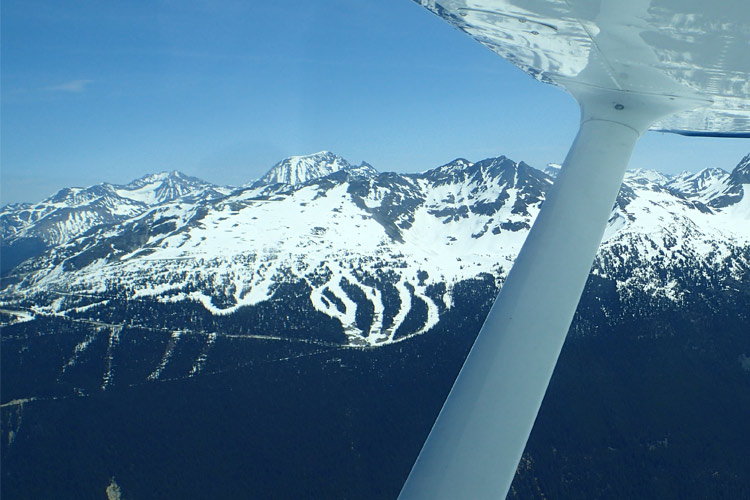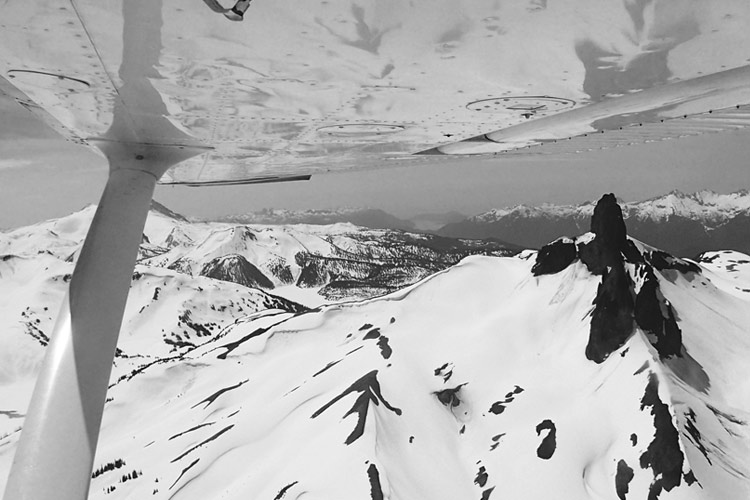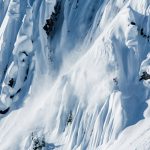Whistler is beautiful, and the higher you get the better it looks.
At 670m (2198 feet) of elevation, the Whistler valley is lush with rainforest vegetation, sparkling clean water, hundreds of species of animals, and enormous forests of cedar, fir, hemlock, pine and more. The mountains and glaciers stand tall above it all like sentinels of a long-ago era.

Up on top of those mountains however, things get even more impressive. At 2,184 m (7,165 feet) the peak of Whistler mountain offers sweeping views in all directions of snowy peaks, hanging glaciers, extinct volcanoes and all around general awesomeness.
So imagine how good everything looks like a few thousand meters above that?
“That’s the reason I started flying,” says pro-skier/pilot Rory Bushfield. “I just wanted to look at the mountains. See them better, see more of them, see it all.”
“Bushy” flies a 1953 Cessna 180 and says his original reason for flying in the area was to search out new places to ski but he quickly fell in love with just flying around. “The Tantalus Glacier is my favourite place to fly. Whenever I have friends in town that is the first place we hit…great passes and views in there.”
Floatplanes
But you don’t need to be an ace pilot with a hugely impressive Instagram feed to enjoy those Tantalus views or experience Whistler from the air. Harbour Air operates Whistler Air, Whistler’s only floatplane service. They offers a plethora of tours of the local mountains, including an alpine lake landing in one of the area’s most celebrated (and secretive) spots. They’ve even wrapped select floatplanes in red and white to celebrate Canada’s 150th.

Helicopters
Helicopter sightseeing (or heli hiking) tours are another option for appreciating the bird’s eye view and the helicopter is more functional for landing in remote spots but there is something magical about the flow and glide of a fixed wing aircraft.
“Just being able to get over the valleys and mountains so quickly is amazing,” Rory says. “There are so many surprises out there: caves and cracks and notches and pillars. Huge glaciers, mountains with flat-top peaks…every time I go out I find something new to see or see something in a new way because the sun is hitting it differently or the snow has accumulated in a new way. Being able to see everything from the air… it’s seeing the truth.”

Book your own Whistler aerial sightseeing tour at Whistler.com or knock off two birds with one stone by booking a floatplane shuttle from Vancouver to Whistler so you can see the sights as you arrive. (Heads Up: Once the lakes freeze the floatplanes stop running – so get in now)
The Beaver and the Otter Celebrate Canada’s 150th
Canada is literally covered with lakes (apparently we have 20% of the freshwater on earth!) so float planes have played an integral role in the exploration and expansion of our nation. To celebrate the 150th birthday of Canada, Harbour air is celebrating two of the classic aircraft models that helped open up the vast Canadian landscape by dressing them up in stunning red and white maple leaf colours.
“The Otter and the Beaver are iconic in aviation and Canadian history,” says Greg McDougall, the CEO of Harbour Air and a former bush pilot himself. “These aircraft were designed and manufactured right here in Canada and we still fly them today, a testament to their reliability.”
The first de Havillard Beaver planes were built in Toronto in 1947 and the first Otter hit the skies in 1952. With short take-off and landing capabilities, as well as the ability to adapt the landing gear to take floats, wheels or even skis, both aircraft were instrumental in accessing remote parts of Canada. So booking a tour or shuttle with Harbour Air not only gives you unparalleled views and perspective on the stunning Coast Mountain landscape, you are also flying in a piece of Canadian history.
“We thought it was only fitting to mark Canada’s 50th by honouring the Otter and the Beaver,” McDougall says. “The two aircraft that opened up and united this vast country.”


